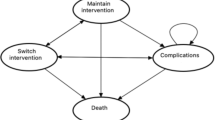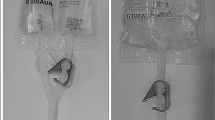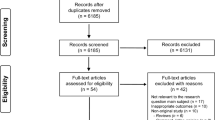Abstract
Study design
Systematic review and network meta-analysis.
Objectives
Intermittent catheterization (IC) is considered the standard treatment for neuro-urological patients who are unable to empty their bladders. The present study aimed to conduct a systematic evaluation and network meta-analysis of all available types of intermittent catheters, and determine which one is best suited for clinical use.
Methods
We searched MEDLINE, EMBASE and Cochrane Central Register of Controlled Trials (CENTRAL) databases to identify relevant studies. Only randomized clinical trials (RCTs) were included. Five types of catheters were identified based on the included studies. A Bayesian network meta-analysis was then performed. The surface under the cumulative ranking (SUCRA) curve was used to determine the best catheter for each outcome.
Results
A total of 25 RCTs, involving 1233 participants, were included. The pooled odds ratios of symptomatic UTI were lower for two ready-to-use single-use catheters (gel-lubricated non-coated catheter, OR: 0.30, 95% CI 0.095–0.86; pre-activated hydrophilic-coated catheter, OR: 0.41, 95% CI 0.19–0.83) as compared to single-use non-coated catheter. In terms of patient satisfaction, the SUCRA results showed that the pre-activated hydrophilic-coated catheter may the preferred option (SUCRA = 82.8%). However, there were no significant differences in all outcome measures between traditional single-use non-coated catheters and clean non-coated catheters.
Conclusion
Ready-to-use single-use catheters are associated with lower rates of UTI compared to traditional catheters. Patients may be most satisfied with the pre-activated one. For traditional single-use non-coated catheters and clean non-coated catheters, there is still no convincing evidence as to which is better. Thus, more well-designed trials are needed.
Similar content being viewed by others
Login or create a free account to read this content
Gain free access to this article, as well as selected content from this journal and more on nature.com
or
References
Blok B, Padilla-Fernández B, Pannek J, Castro-Diaz D, Del Popolo G, Groen J, et al. EAU Guidelines on Neuro-Urology 2018. European Association of Urology Guidelines 2018 Edition. presented at the EAU Annual Congress Copenhagen 2018. Arnhem: European Association of Urology Guidelines Office; 2018.
Wyndaele JJ. Complications of intermittent catheterization: their prevention and treatment. Spinal Cord. 2002;40:536–41.
Abrams P, Andersson KE, Birder L, Brubaker L, Cardozo L, Chapple C, et al. Fourth International Consultation on Incontinence Recommendations of the International Scientific Committee: evaluation and treatment of urinary incontinence, pelvic organ prolapse, and fecal incontinence. Neurourol Urodyn. 2010;29:213–40.
Guttmann L, Frankel H. The value of intermittent catheterisation in the early management of traumatic paraplegia and tetraplegia. Paraplegia. 1966;4:63–84.
Lapides J, Diokno AC, Lowe BS, Kalish MD. Followup on unsterile intermittent self-catheterization. J Urol. 1974;111:184–7.
Diokno AC, Mitchell BA, Nash AJ, Kimbrough JA. Patient satisfaction and the LoFric catheter for clean intermittent catheterization. J Urol. 1995;153:349–51.
Waller L, Telander M, Sullivan L. The importance of osmolality in hydrophilic urethral catheters: a crossover study. Spinal Cord. 1997;35:229–33.
Charbonneau-Smith R. No-touch catheterization and infection rates in a select spinal cord injured population. Rehabil Nurs. 1993;18:296–9. 305.
Giannantoni A, Di Stasi SM, Scivoletto G, Virgili G, Dolci S, Porena M. Intermittent catheterization with a prelubricated catheter in spinal cord injured patients: a prospective randomized crossover study. J Urol. 2001;166:130–3.
Pascoe G, Clovis S. Evaluation of two coated catheters in intermittent self-catheterization. Br J Nurs. 2001;10:325–9.
Bermingham SL, Hodgkinson S, Wright S, Hayter E, Spinks J, Pellowe C. Intermittent self catheterisation with hydrophilic, gel reservoir, and non-coated catheters: a systematic review and cost effectiveness analysis. BMJ. 2013;346:e8639.
Li L, Ye W, Ruan H, Yang B, Zhang S, Li L. Impact of hydrophilic catheters on urinary tract infections in people with spinal cord injury: systematic review and meta-analysis of randomized controlled trials. Arch Phys Med Rehabil. 2013;94:782–7.
Prieto J, Murphy CL, Moore KN, Fader M. Intermittent catheterisation for long-term bladder management. Cochrane Database Syst Rev. 2014;9:CD006008.
Rognoni C, Tarricone R. Intermittent catheterisation with hydrophilic and non-hydrophilic urinary catheters: systematic literature review and meta-analyses. BMC Urol. 2017;17:4.
Clark JF, Mealing SJ, Scott DA, Vogel LC, Krassioukov A, Spinelli M, et al. A cost-effectiveness analysis of long-term intermittent catheterisation with hydrophilic and uncoated catheters. Spinal Cord. 2015;54:73–7.
Prieto J, Murphy CL, Moore KN, Fader M. WITHDRAWN: Intermittent catheterisation for long-term bladder management. Cochrane Database Syst Rev. 2017;8:Cd006008.
Christison K, Walter M, Wyndaele JJM, Kennelly M, Kessler TM, Noonan VK, et al. Intermittent catheterization: the devil is in the details. J Neurotrauma. 2018;35:985–9.
Hutton B, Salanti G, Caldwell DM, Chaimani A, Schmid CH, Cameron C, et al. The PRISMA extension statement for reporting of systematic reviews incorporating network meta-analyses of health care interventions: checklist and explanations. Ann Intern Med. 2015;162:777–84.
Hooton TM, Bradley SF, Cardenas DD, Colgan R, Geerlings SE, Rice JC, et al. Diagnosis, prevention, and treatment of catheter-associated urinary tract infection in adults: 2009 International Clinical Practice Guidelines from the Infectious Diseases Society of America. Clin Infect Dis. 2010;50:625–63.
Roberts KB. Urinary tract infection: clinical practice guideline for the diagnosis and management of the initial UTI in febrile infants and children 2 to 24 months. Pediatrics. 2011;128:595–610.
van Valkenhoef G, Lu G, de Brock B, Hillege H, Ades AE, Welton NJ. Automating network meta-analysis. Res Synth Methods. 2012;3:285–99.
Neupane B, Richer D, Bonner AJ, Kibret T, Beyene J. Network meta-analysis using R: a review of currently available automated packages. PLoS ONE. 2014;9:e115065.
Salanti G, Ades AE, Ioannidis JP. Graphical methods and numerical summaries for presenting results from multiple-treatment meta-analysis: an overview and tutorial. J Clin Epidemiol. 2011;64:163–71.
Higgins JP, Thompson SG. Quantifying heterogeneity in a meta-analysis. Stat Med. 2002;21:1539–58.
Lu G, Ades AE. Assessing evidence inconsistency in mixed treatment comparisons. J AM Stat Assoc 2006;101:447–59.
Dias S, Welton NJ, Caldwell DM, Ades AE. Checking consistency in mixed treatment comparison meta-analysis. Stat Med. 2010;29:932–44.
King RB, Carlson CE, Mervine J, Wu Y, Yarkony GM. Clean and sterile intermittent catheterization methods in hospitalized patients with spinal cord injury. Arch Phys Med Rehabil. 1992;73:798–802.
Quigley PA, Riggin OZ. A comparison of open and closed catheterization techniques in rehabilitation patients. Rehabil Nurs. 1993;18:26–9. 33.
Duffy LM, Cleary J, Ahern S, Kuskowski MA, West M, Wheeler L, et al. Clean intermittent catheterization: safe, cost-effective bladder management for male residents of VA nursing homes. J Am Geriatr Soc. 1995;43:865–70.
Sutherland RS, Kogan BA, Baskin LS, Mevorach RA. Clean intermittent catheterization in boys using the LoFric catheter. J Urol. 1996;156:2041–3.
Prieto-Fingerhut T, Banovac K, Lynne CM. A study comparing sterile and nonsterile urethral catheterization in patients with spinal cord injury. Rehabil Nurs. 1997;22:299–302.
Pachler J, Frimodt-Moller C. A comparison of prelubricated hydrophilic and non-hydrophilic polyvinyl chloride catheters for urethral catheterization. BJU Int. 1999;83:767–9.
Schlager TA, Clark M, Anderson S. Effect of a single-use sterile catheter for each void on the frequency of bacteriuria in children with neurogenic bladder on intermittent catheterization for bladder emptying. Pediatrics. 2001;108:E71.
Day RA, Moore KN, Albers MK. A pilot study comparing two methods of intermittent catheterization: limitations and challenges. Urol Nurs. 2003;23:143–7. 58.
Vapnek JM, Maynard FM, Kim J. A prospective randomized trial of the LoFric hydrophilic coated catheter versus conventional plastic catheter for clean intermittent catheterization. J Urol. 2003;169:994–8.
De Ridder DJ, Everaert K, Fernandez LG, Valero JV, Duran AB, Abrisqueta ML, et al. Intermittent catheterisation with hydrophilic-coated catheters (SpeediCath) reduces the risk of clinical urinary tract infection in spinal cord injured patients: a prospective randomised parallel comparative trial. Eur Urol. 2005;48:991–5.
Stensballe J, Looms D, Nielsen PN, Tvede M. Hydrophilic-coated catheters for intermittent catheterisation reduce urethral micro trauma: a prospective, randomised, participant-blinded, crossover study of three different types of catheters. Eur Urol. 2005;48:978–83.
Moore KN, Burt J, Voaklander DC. Intermittent catheterization in the rehabilitation setting: a comparison of clean and sterile technique. Clin Rehabil. 2006;20:461–8.
Cardenas DD, Hoffman JM. Hydrophilic catheters versus noncoated catheters for reducing the incidence of urinary tract infections: a randomized controlled trial. Arch Phys Med Rehabil. 2009;90:1668–71.
Sarica S, Akkoc Y, Karapolat H, Aktug H. Comparison of the use of conventional, hydrophilic and gel-lubricated catheters with regard to urethral micro trauma, urinary system infection, and patient satisfaction in patients with spinal cord injury: a randomized controlled study. Eur J Phys Rehabil Med. 2010;46:473–9.
Cardenas DD, Moore KN, Dannels-McClure A, Scelza WM, Graves DE, Brooks M, et al. Intermittent catheterization with a hydrophilic-coated catheter delays urinary tract infections in acute spinal cord injury: a prospective, randomized, multicenter trial. PM R. 2011;3:408–17.
Denys P, Prévinaire JG, Aegerter P, de Sèze M, Karsenty G, Amarenco G. Intermittent self-catheterization habits and opinion on aseptic VaPro catheter in French neurogenic bladder population. Spinal Cord. 2012;50:853–8.
Chartier-Kastler E, Amarenco G, Lindbo L, Soljanik I, Andersen HL, Bagi P, et al. A prospective, randomized, crossover, multicenter study comparing quality of life using compact versus standard catheters for intermittent self-catheterization. J Urol. 2013;190:942–7.
Chick HE, Hunter KF, Moore KN. Parent and child experiences using a hydrophilic or reused PVC catheter for intermittent catheterisation. J Clin Nurs. 2013;22:513–20.
Leek H, Stephenson Z, Reus A, Karantanis E, Moore K. Clean intermittent self-catheterisation: a randomised controlled crossover trial of single-use versus multiple re-use of non-coated catheters; is cystitis rate altered? Neurourol Urodyn. 2013;32:759–60.
Kiddoo D, Sawatzky B, Bascu CD, Dharamsi N, Afshar K, Moore KN. Randomized Crossover Trial of Single Use Hydrophilic Coated vs Multiple Use Polyvinylchloride Catheters for Intermittent Catheterization to Determine Incidence of Urinary Infection. J Urol. 2015;194:174–9.
Lucas EJ, Baxter C, Singh C, Mohamed AZ, Li B, Zhang J, et al. Comparison of the microbiological milieu of patients randomized to either hydrophilic or conventional PVC catheters for clean intermittent catheterization. J Pediatr Urol. 2016;12:172.e1–8.
DeFoor W, Reddy P, Reed M, VanderBrink B, Jackson E, Zhang B, et al. Results of a prospective randomized control trial comparing hydrophilic to uncoated catheters in children with neurogenic bladder. J Pediatr Urol. 2017;13:373.e1–e5.
Madero-Morales PA, Robles-Torres JI, Vizcarra-Mata G, Guillén-Lozoya AH, Mendoza-Olazarán S, Garza-González E, et al. Randomized clinical trial using sterile single use and reused polyvinylchloride catheters for intermittent catheterization with a clean technique in spina bifida cases: short-term urinary tract infection outcomes. J Urol. 2019;202:153–8.
Goessaert AS, Antoons S, Van Den Driessche M, Tourchi A, Pieters R, Everaert K. No-touch intermittent catheterization: caregiver point of view on sterility errors, duration, comfort and costs. J Adv Nurs. 2013;69:2000–7.
NIDRR. The prevention and management of urinary tract infections among people with spinal cord injuries. National Institute on Disability and Rehabilitation Research Consensus Statement. J Am Paraplegia Soc. 1992;15:194–204.
Funding
This study is supported by grants from 1.3.5 project for disciplines of excellence, West China Hospital, Sichuan University (ZYGD18011, ZY2016104 and ZYJC18015).
Author information
Authors and Affiliations
Contributions
Study design: DHY and YTC; data collection: ZYJ and BHL; data analysis: DHY, XJ, and LYX; writing of this paper: DHY and YTC; revision of this paper: DHY, HL, and KJW.
Corresponding authors
Ethics declarations
Conflict of interest
The authors declare no competing interests.
Additional information
Publisher’s note Springer Nature remains neutral with regard to jurisdictional claims in published maps and institutional affiliations.
Supplementary information
Rights and permissions
About this article
Cite this article
Ye, D., Chen, Y., Jian, Z. et al. Catheters for intermittent catheterization: a systematic review and network meta-analysis. Spinal Cord 59, 587–595 (2021). https://doi.org/10.1038/s41393-021-00620-w
Received:
Revised:
Accepted:
Published:
Issue Date:
DOI: https://doi.org/10.1038/s41393-021-00620-w
This article is cited by
-
Impact of urinary catheters including reusable catheters on quality of life and work productivity in persons with spinal cord lesion
Scientific Reports (2024)
-
The urological evaluation and management of neurogenic bladder in children and adolescents—what every pediatric nephrologist needs to know
Pediatric Nephrology (2024)
-
A scoping review on the impact of hydrophilic versus non-hydrophilic intermittent catheters on UTI, QoL, satisfaction, preference, and other outcomes in neurogenic and non-neurogenic patients suffering from urinary retention
BMC Urology (2022)



